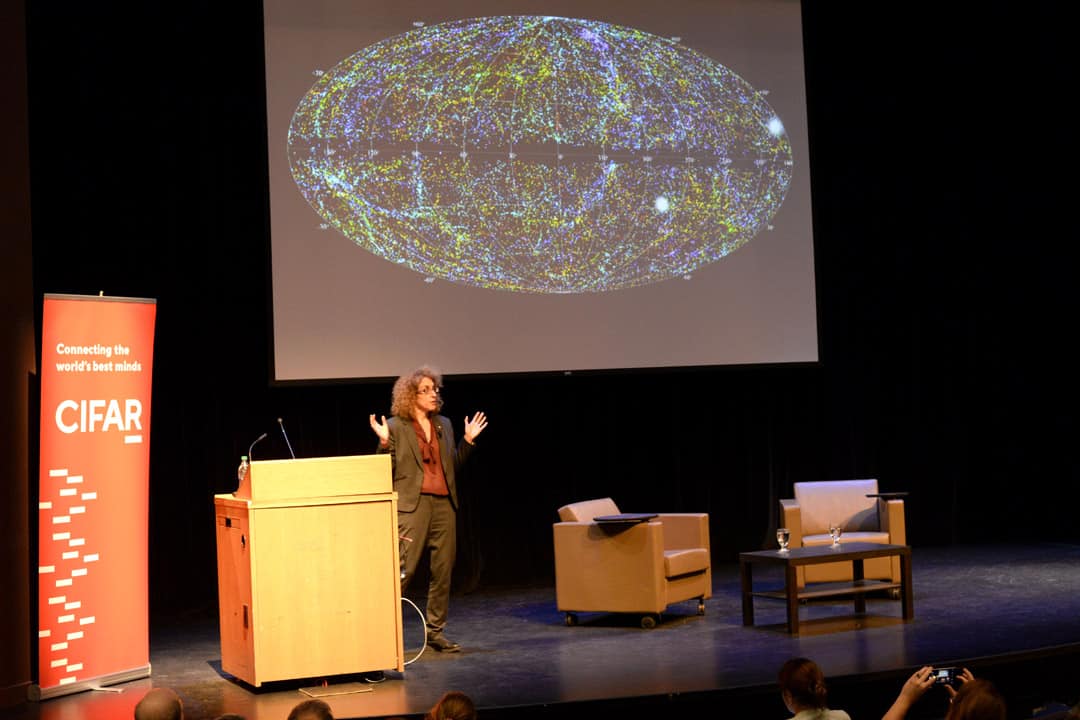Dr. Victoria Kaspi delivered the 2018 Canadian Institute for Advanced Research Massey Talk at the Isabel Bader Theatre last week, explaining her team’s successful search for the origin of a repeating fast radio burst (FRB) and their future steps.
FRBs refer to rapid but brief radio wave emissions that are detected from outside of our galaxy. Although up to 10,000 bursts may be recorded on any given day, very little is known about them.
In 2001, a Parkes Observatory radio telescope in Australia recorded a flurry of radio frequencies from the distant reaches of the observable universe.
Since the confirmation of FRBs in 2007, more than 50 different FRBs have been detected by astronomers across the globe.
Kaspi embarked on her search using theoretical physics
To track the source of repeating FRBs, Kaspi had to accurately guide telescopes by way of dispersion.
This physical phenomenon occurs when light passes through a medium, like a glass prism, and the components of light — electromagnetic radiation (EMR) — separate based on their wavelength, or colour.
The phenomenon can be seen when rainbows are formed, Kaspi explained, as the medium of “water droplets in the air will split — disperse — white light from the sun.”
“There’s also a time dispersion,” said Kaspi. “And if you could pulse the prism, you would see that the colours arrive at slightly different times. Different colours travel at different speeds in a medium, like glass or water.”
With this in mind, the distance travelled by FRBs was measured based on the “sweep” of the data — the range between the time at which the highest-frequency EMR waves hit the detector and the time that the lowest-frequency EMR waves hit the detector.
For an FRB, Kaspi said that the sweep helps to “[tell] us the distance, roughly speaking, to the source.”
Radio waves are dispersed because “interstellar space is not a vacuum,” explained Kaspi. “There’s dust, there’s neutral atoms, there’s ionized atoms, in particular, there’s free electrons. There are free electrons throughout the galaxy, and it’s those free electrons that disperse radio waves.”
Zeroing in on the origin of a repeating FRB
Starting with data from the Parkes radio telescope, Kaspi’s research group guided a radio telescope known as the Arecibo Observatory in Puerto Rico to zero in on a repeating FRB — that is, a set of FRBs detected on Earth that are from the same origin point.
“Parkes is really good at finding [FRBs] because it sees a large area of the sky at once,” said Kaspi. “But it can’t pinpoint. Anything that can pinpoint, can’t detect them, because they’re looking at too small fractions of the sky.”
Using the data from the Parkes Observatory to narrow their focus, Kaspi’s research group fixed the radio telescope at the Arecibo Observatory on the FRB’s approximate area of origin.
The telescope at the Arecibo Observatory is remarkably accurate. “You can just stare and wait,” said Kaspi about locating the origin point of an FRB. “And that’s exactly what we did.”
They eventually pinpointed the FRB’s source to a dwarf galaxy.
What causes FRBs?
The exact cause of FRBs remains to be determined, but Kaspi’s discovery has narrowed down the possible events that cause FRBs to occur.
Theories have ranged from “exploding stars [and] colliding stars,” to “comets and asteroids impacting neutron stars, black holes evaporating, primordial cosmic strings, oscillations,” explained Kaspi. “But the bottom line is that we don’t know the answer.”
Finding evidence that an FRB can repeat from a dwarf galaxy has eliminated the possibility of FRBs originating from “self-destructive, cataclysmic events that could only occur once,” as suggested in a 2016 BBC article.
But the FRBs likely have “nothing to do with any intelligent lifeforms,” said Kaspi. “We are very confident this is a natural phenomenon.”
What’s next in Canadian FRB research?
Supported by funding from the Canadian Foundation of Innovation, FRB research is an ongoing and collaborative effort led by the University of Toronto, McGill University, the University of British Columbia, the National Research Council, and the Dominion Radio Astrophysical Observatory.
These efforts have culminated in the Canadian Hydrogen Intensity Mapping Experiment (CHIME) and the construction of the CHIME telescope in British Columbia, “the world’s most powerful fast radio burst detector today,” said Kaspi.
“Nature magazine wrote an article about what to expect in 2018… and the very first thing they mentioned — no pressure here — was CHIME and fast radio bursts,” said Kaspi. “It’s a very exciting time, and we’re all working hard to get this science out fast.”


